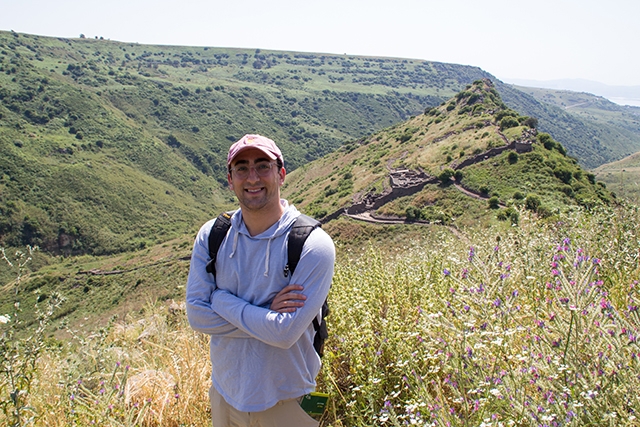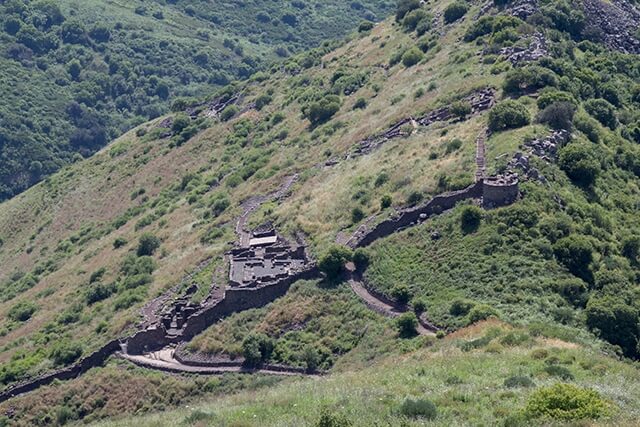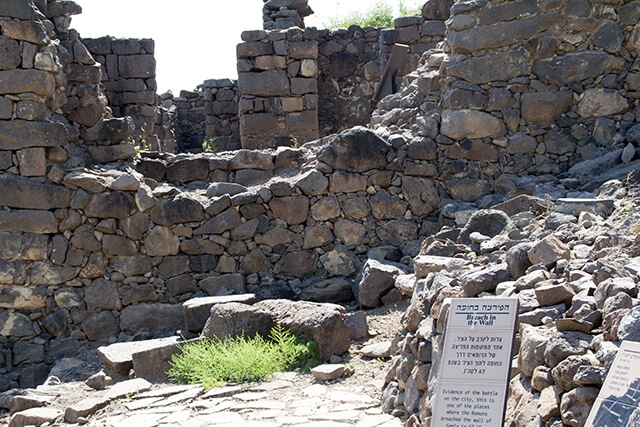News
Shlomo Cahlon hikes along the path to the ruined city of Gamla, high in the hills to the northeast of Jerusalem. (Photo courtesy of Shlomo Cahlon)
A scorching sun beat down on an army of 60,000 Roman soldiers trudging up the steep hill that led to the fortified city of Gamla, perched high above the Sea of Galilee.
The 9,000 Jews who lived within the city walls were preparing, with a mixture of defiance and trepidation, for the siege they knew was coming—there was only one way in and out of the city.
The seven-month siege of Gamla, during which the Jews heroically repelled their attackers several times before the Romans breached the wall, seized the city and brutally slaughtered its inhabitants, is chronicled in “The Jewish War,” written by historian Flavius Josephus in 75 C.E.
Today, Gamla is an archeological site located about 125 miles northeast of Jerusalem. But for Shlomo Cahlon, the city ruins recently doubled as a Harvard classroom.
Cahlon, A.B. ’21, hiked up to the ruins to attend class for “Josephus” (JEWISHT 129), taught by Shaye Cohen, Littauer Professor of Hebrew Literature and Philosophy, in which Cahlon and his classmates are studying “The Jewish War” and other works by the prolific historian.
The ancient city of Gamla, perched on a hillside, was surrounded by a stone wall with only one path leading into and out of the city. (Photo courtesy of Shlomo Cahlon)
“As you read the story, Josephus describes how incredibly difficult it was for the Romans to even get to the city, and I felt that. It was hot (more than 90 degrees), it is up a steep hill and a long, exhausting walk up and down into the valley,” he said. “I had my backpack, but I can’t believe how miserable it would have been for the Roman soldiers carrying all that equipment, let alone for the Jews who were under siege fighting for their independence. When you see how difficult that must have been, and for such a small city so far out of the way, you realize how determined the Romans needed to be to capture it.”
For Cahlon, whose home is about 120 miles from Gamla in Tel Aviv, the chance to attend a Harvard history class in the exact spot where the events took place was an opportunity too good to pass up.
He logged into Zoom, using his phone to transmit WiFi because the signal was so weak, and managed to give his classmates a quick glimpse of the ruined city before the spotty connection forced him to retreat inside so he could join the class discussion.
“It may have been as hard to find a signal in Gamla as it was to conquer it,” he mused.
After the lecture, with the vivid descriptions penned by Josephus still ringing in his ears, Cahlon walked through the city and took it all in. He stopped near the gaping hole where the Roman army first crashed through the city wall. Then he stood near the site of the ancient synagogue and the mikveh, a bathing house used for ritualistic cleansing, and considered what life was like for Gamla’s inhabitants.
This image shows where the Roman army breached the city walls of Gamla, enabling 60,000 troops to pour in and conquer the city. (Photo courtesy of Shlomo Cahlon)
“I could imagine them going to early services at the synagogue and then going out to work in the fields. I could see the pits outside the city where they would collect water from rainstorms to use in the baths to cleanse themselves,” he said. “I actually saw how Jews lived independently, not far from where I live today, over 1,900 years ago. That is something you can’t understand just by reading.”
For Cahlon, studying Josephus in college is almost like coming full circle. His family kept a copy of “The Jewish War” in their library, and he learned the stories as a child.
“Sometimes, when you are reading a history book, it feels like just a story,” he said. “But standing there, I almost felt like I was living it all again. I closed my eyes and I could imagine how all these things happened here.”
Being able to attend class in Gamla is one benefit of remote instruction; Cahlon has been attending class via Zoom since he returned home to Tel Aviv after Harvard’s campus closed in March, 2020, due to the COVID-19 pandemic.
Seeking out meaningful experiences, even in the midst of a global pandemic, has been a driving force for Cahlon, who is concentrating in computer science and astrophysics, with a secondary in the comparative study of religion. He is also an undergraduate technology innovation fellow at the John A. Paulson School of Engineering and Applied Sciences and Harvard Business School. Cahlon recently finished his senior thesis, in which he studied molecular clouds in the Milky Way Galaxy in 3D.
“In addition to astrophysics, another field that aims to answer some of life’s biggest questions is comparative study of religion. The comparative religion department provides me with a different lens,” he said. “Studying STEM and the humanities has broadened my horizons and provided me with a larger, better equipped toolbox.”
And the perspective he gained from his visit to Gamla not only provided context for the writings of Josephus, it emphasized to Cahlon the importance of embracing opportunities to keep broadening his horizons.
Topics: Academics, Undergraduate Student Profile
Cutting-edge science delivered direct to your inbox.
Join the Harvard SEAS mailing list.
Press Contact
Adam Zewe | 617-496-5878 | azewe@seas.harvard.edu





